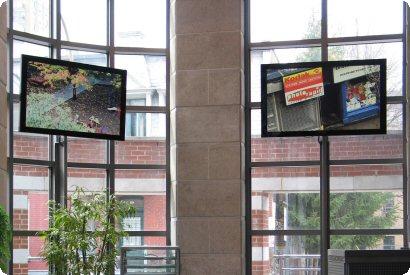David Rokeby, Machine for Taking Time
(Boul. Saint-Laurent), 2007
Documentary Collection
In 2001, Canadian artist David Rokeby was commissioned by the Oakville Galleries to produce a work for the garden adjacent to one of its galleries. In response, the artist created Machine for Taking Time, a work in which he used a surveillance camera, not to monitor the people strolling through the garden, but rather to track the changes taking place in the landscape day by day and season by season. (2) As the title implies, the focus of the work is time. The images captured by the surveillance camera were integrated into an image bank and projected onto a screen suspended from the ceiling in the Gairloch Gardens Gallery of Oakville Galleries.
The work was the subject of three exhibitions in Oakville: Earthly Delights: Deep Gardening (summer 2001); the Rokeby retrospective (summer-fall 2004); and Outlook Express(ed) (summer 2007). In the interim, having become itinerant despite its in situ conception, Machine for Taking Time was featured in Time and Place, an exhibition held at the Pari Nadimi Gallery, which represents the artist in Toronto. In 2006, the Harbourfront Centre in Toronto presented the work as part of Timeless – Time, Landscape and New Media. In the case of the latter two exhibitions, the mise en abyme was not possible, as the garden where the images were recorded could no longer be associated with the place where they were projected. In Oakville, the projection screen had been suspended in front of a window looking over the garden itself.
In the fall of 2005, Jean Gagnon, then executive director of the Daniel Langlois Foundation, asked Rokeby to create a version of Machine for Taking Time for the Ex-Centris building in Montreal. Entitled Machine for Taking Time (Boul. Saint-Laurent), the work was first presented to the public on September 14, 2007, and was part of the exhibition e-art: New Technologies and Contemporary Art: Ten years of Accomplishments by the Daniel Langlois Foundation. (3) Acquired by the Foundation, the work was exhibited at Ex-Centris until April 6, 2009. While still inspired by the original idea of capturing images at various times of the day and season, Rokeby altered his initial concept by using two cameras. One, positioned on the Ex-Centris facade, captured images of Saint-Laurent Boulevard and the surrounding buildings. The other, installed at the rear of the Ex-Centris building, took images of the interior courtyard, a playground, and the roofs of buildings on Clark Street. The decision to install two cameras stemmed not only from the artist’s interest in capturing views from both angles, but also because he knew that Saint-Laurent Boulevard had long been considered the line dividing Montreal’s francophone and anglophone population. He saw in this aspect a particularly interesting sidebar to his work. The recording, which began on January 23, 2006, lasted just over one year, enabling the artist to capture images from all four seasons.
Rokeby did not use the same type of camera in the work’s two versions. In Oakville, he chose a standard surveillance camera, while for the Foundation, he opted for IP (Internet protocol) cameras, also known as network cameras, which allowed him to view the images in real time and adjust the devices from his Toronto studio using a Web browser. He stored the images captured by the cameras in two separate databases. The work was displayed in the Ex-Centris lobby on two plasma screens suspended in front of the windows facing the building’s interior courtyard.
A number of questions are currently being considered about the future of this work. Is it possible to reinstall the cameras on the roof to capture new images? Can it be exhibited at Ex-Centris only? Or, like the first version, might it become itinerant? In other words, can it exist beyond its original context? Once the opportunity presents itself, a new dialogue will be initiated between the Daniel Langlois Foundation and David Rokeby.
Ariane Noël de Tilly © 2009 FDL
The National Gallery of Canada bought in 2016 an edition of Machine for Taking Time, which was overhauled for the occasion. A third edition was shown by Molior during the exhibition Rhythms of the Imagination, Technological Tools and Works, from November 10 to 19, 2016 at the Hexagram-Concordia Black Box,Montreal (curator: Marie Perrault).
© 2017 FDL
(1) This Documentary Collection was compiled in 2008 by Ludovic Carpentier with the help of David Rokeby, Ariane Noël de Tilly (Universiteit van Amsterdam), Richard Gagnier (Montreal Museum of Fine Arts), Julie Bourbonnais (Docam), and Jean-François Morasse (Ex-Centris).
(2) Machine for Taking Time is neither the first nor only work by Rokeby to make use of surveillance cameras. In fact, since the early 1980s the artist has been integrating them into his work and in a few cases has even built them himself. In his works such as Watch (1995), Watched and Measured (2000), Seen (2002) and Taken (2002), the surveillance camera is at the heart of the installation.
(3) This exhibition was a joint initiative of the Daniel Langlois Foundation and the Montreal Museum of Fine Arts from September 20 to December 9, 2007 (currator: Jean Gagnon).
Index:
- Documentary Collection
• Introduction
• Interview with David Rokeby
• Installation views
• Selection of images
• Exhibition context
• Technical details
• Other installations
• Links and Resources
Related pages:
 David Rokeby
David RokebyDavid Rokeby is an interactive sound and video installation artist based in Toronto, Canada.
 David Rokeby, The Giver of Names (1991-)
David Rokeby, The Giver of Names (1991-)This documentary collection maintains the tension between the ideal notion and the real manifestation of the artwork.
 David Rokeby, Very Nervous System (1983-)
David Rokeby, Very Nervous System (1983-)Very Nervous System celebrity and longevity pose some particularly interesting questions about documentation and contextualisation of media artworks over time and through change.






